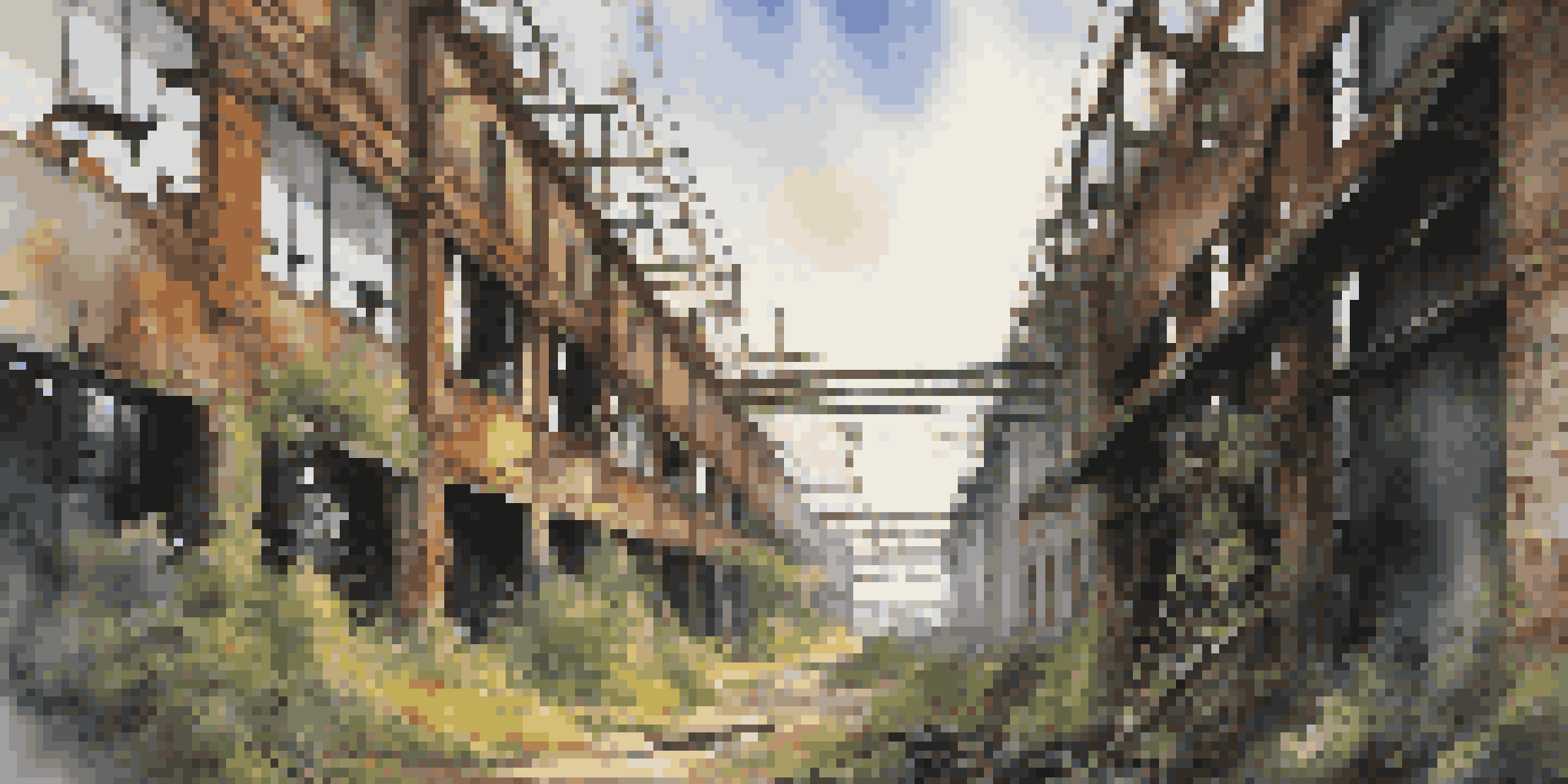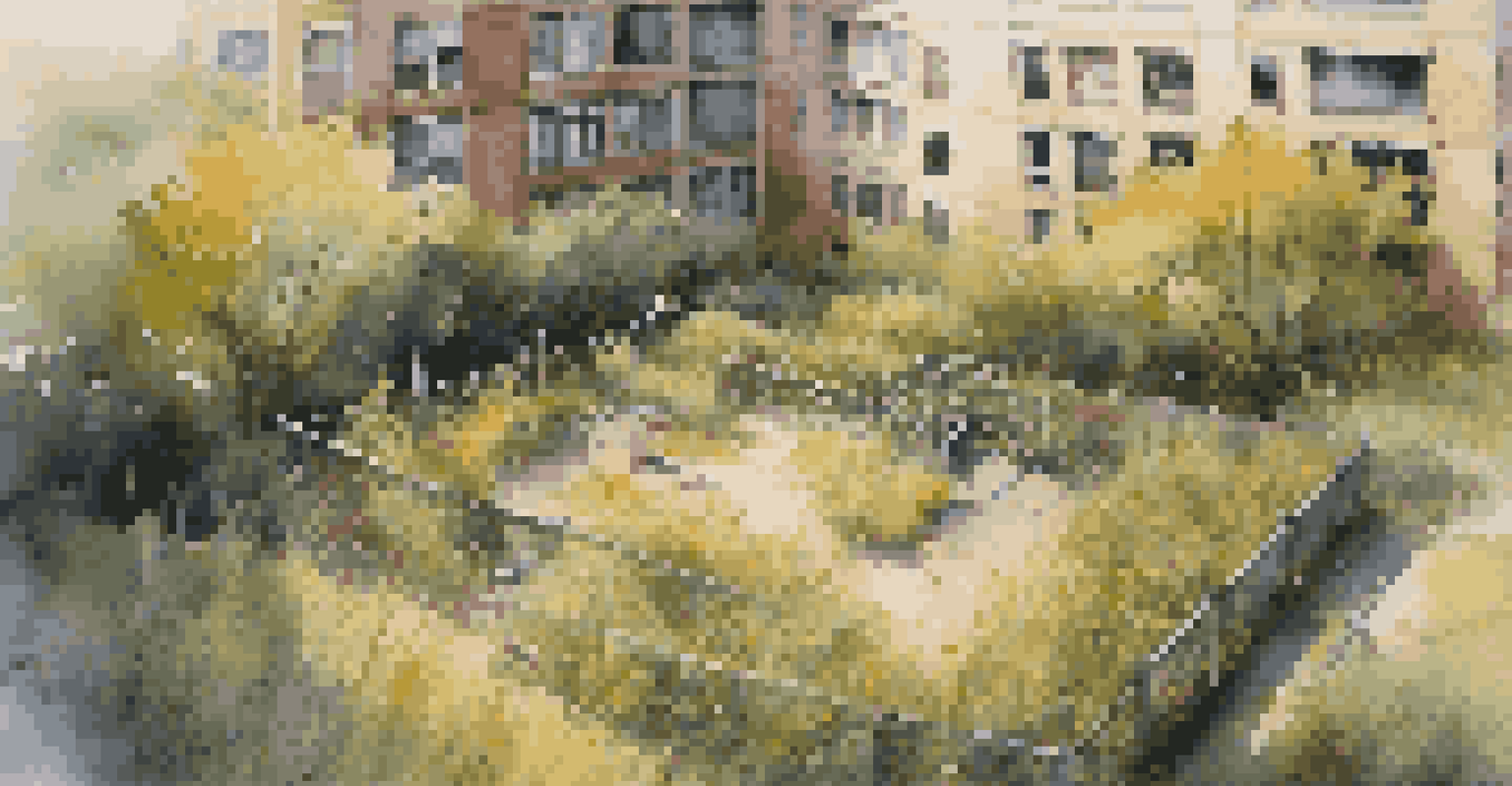Urban Exploration in Film: How Movies Portray Abandonment

The Rise of Urban Exploration in Cinema
Urban exploration, often abbreviated as 'urbex', has gained traction in films as a way to delve into forgotten spaces. Movies are increasingly showcasing abandoned buildings and derelict urban landscapes, inviting viewers to ponder what once was. This cinematic trend reflects a broader fascination with decay and nostalgia, engaging audiences with the stories these spaces could tell.
Abandonment in film often symbolizes isolation, lost potential, and the passage of time.
Filmmakers use urban exploration to evoke a sense of mystery and adventure, often framing their narratives around characters who venture into these forgotten realms. The visuals of crumbling structures and overgrown vegetation can stir emotions, leading viewers to reflect on themes of loss and the passage of time. This exploration not only serves as a backdrop but also becomes a character in its own right.
By incorporating elements of urbex, filmmakers tap into a collective curiosity about the past and the remnants of human life. It challenges audiences to confront the transient nature of existence while fostering a deeper appreciation for the beauty found in decay. The rise of this theme in cinema invites a discussion about our relationship with abandoned spaces and what they signify.
Symbolism of Abandonment in Film
Abandonment in film often symbolizes isolation, lost potential, and the passage of time. These themes resonate deeply with audiences, making them more relatable and poignant. For instance, a deserted factory may represent the decline of industry, reflecting societal changes that affect individual lives.

Films like 'The Road' and 'I Am Legend' use desolate landscapes to illustrate the aftermath of human actions and the fragility of civilization. The abandoned environments serve as a canvas for characters' inner struggles, highlighting their emotional states and existential dilemmas. This juxtaposition of character and setting creates a rich narrative experience.
Urban Exploration Captivates Cinema
Films increasingly showcase abandoned spaces to evoke themes of nostalgia and decay.
Moreover, the portrayal of abandonment can evoke a sense of nostalgia, reminding viewers of places once vibrant with life. This connection to the past can spark a mix of emotions, from sadness to longing, as audiences reflect on their own experiences with loss and change. It encourages a deeper understanding of how environments shape human experiences.
Notable Films Featuring Urban Exploration
Several films stand out for their portrayal of urban exploration and abandonment, each offering a unique perspective. 'The Last House on the Left' and 'Cloverfield' are examples where abandoned spaces play a significant role in the storytelling, heightening tension and unease. These films masterfully blend the thrill of exploration with horror elements, amplifying the stakes for their characters.
The aesthetic of decay plays a pivotal role in how urban exploration is portrayed in cinema.
Another notable film is 'Ghost Town', which showcases an abandoned town's haunting beauty while exploring themes of redemption and second chances. The desolation acts as a backdrop for personal transformation, illustrating how these spaces can trigger profound realizations. This duality of space as both haunting and enlightening is a recurring motif in urban exploration films.
Additionally, documentaries like 'Urban Explorers' delve into the real-life adventures of people who explore abandoned sites. These films not only entertain but also educate viewers about the history and significance of these places. They capture the essence of what urbex represents: curiosity, adventure, and the urge to uncover forgotten stories.
The Aesthetic of Decay in Film
The aesthetic of decay plays a pivotal role in how urban exploration is portrayed in cinema. Filmmakers often use striking visuals of rusted metal, peeling paint, and nature reclaiming urban spaces to create a compelling atmosphere. This visual storytelling invites viewers to appreciate the beauty in decay, challenging conventional ideas of what is considered beautiful.
Cinematography techniques, such as low angles and wide shots, can enhance the sense of scale and isolation in abandoned settings. These techniques immerse the audience in the environment, making them feel as if they are part of the exploration. The slow, lingering shots of crumbling architecture often evoke a melancholic beauty that resonates deeply.
Symbolism of Abandonment Resounds
Abandoned environments in films symbolize isolation and lost potential, resonating deeply with audiences.
Moreover, sound design complements this aesthetic, with echoes, creaks, and distant sounds creating an eerie ambiance. This combination of visuals and sound transports viewers into the world of urban exploration, heightening their emotional response. It reflects how decay can be both haunting and captivating, drawing audiences into a narrative of nostalgia and reflection.
Cultural Impact of Urban Exploration Films
Urban exploration films have sparked a cultural movement, inspiring a new wave of adventurers to seek out abandoned places. This fascination with the forgotten echoes in social media trends, where enthusiasts share their own explorations and experiences. The accessibility of these locations has created a community that appreciates both history and adventure.
However, this cultural impact comes with a responsibility. As interest in urban exploration grows, so does the risk of trespassing and vandalism. Filmmakers have a unique opportunity to promote responsible exploration, encouraging audiences to respect these spaces while marveling at their beauty. This balance between curiosity and respect is crucial for preserving these sites.
Furthermore, the portrayal of urban exploration in film can influence public perception of these spaces. They can shift from being seen as mere abandoned structures to cultural landmarks worthy of preservation. This narrative transformation emphasizes the importance of valuing history and understanding the stories behind these forgotten places.
The Role of Characters in Urban Exploration Films
In urban exploration films, characters often serve as proxies for the audience, allowing viewers to experience the thrill and danger of exploring abandoned spaces. Their journeys reflect a deep-seated human desire for adventure and discovery. As audiences follow these characters, they become invested in their personal stories and challenges.
These characters frequently embody diverse backgrounds and motivations, adding depth to the exploration narrative. Some may seek closure, while others are driven by curiosity or a need to escape their reality. This variety allows for relatable storytelling, as viewers can see parts of themselves in the characters' journeys through forgotten landscapes.
Cultural Movement Around Urbex
Urban exploration films inspire a community of adventurers while emphasizing responsible exploration.
Moreover, the interactions between characters can reveal deeper themes, such as friendship, loss, and the search for meaning. The exploration of abandoned places often becomes a catalyst for self-discovery, pushing characters to confront their fears and desires. This character-driven approach enriches the narrative, making it not just about the spaces, but also about the emotional journeys undertaken within them.
Future Trends in Urban Exploration Films
As urban exploration continues to capture the imagination of filmmakers, we can expect to see evolving narratives and innovative storytelling techniques. With advancements in technology, such as drones and virtual reality, filmmakers can create immersive experiences that transport audiences into abandoned spaces like never before. This new approach could redefine how we perceive and engage with urban exploration in cinema.
Additionally, the blending of genres may become more prevalent, with elements of horror, drama, and even comedy intertwining within urban exploration films. This fusion can lead to more diverse storytelling, appealing to a broader audience while maintaining the core themes of curiosity and adventure. The unexpected combinations may also bring fresh perspectives to the exploration narrative.

Finally, as societal issues continue to emerge, filmmakers may use urban exploration as a lens to address contemporary themes such as gentrification and environmental decay. By weaving these relevant topics into their narratives, they can foster greater awareness and dialogue among audiences. The future of urban exploration in film looks promising, with endless possibilities for storytelling and cultural reflection.